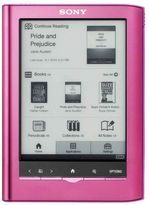Martha wanted to have an e-Book Reader for her birthday. She carefully chose the model she liked the best, having considered type of screen (and preferring an e-ink screen, not a normal LED-based one), page-turning interface (wanted to be able to swipe across the screen), and colour (pink, pretty please!). This turned out to be Sony's PRS 350. So that's not an Apple iPad, then. Shame. But for just e-book reading an iPad is very expensive, it's heavy, and it's got the kind of screen that doesn't work well outdoors. It's also the first non-Apple computing device I've bought for some time ... And several frustrating hours later, I was regretting it.
I'd thought that the setup couldn't take more than 10 minutes — perhaps because I'm too used to Apple products. After all, surely there's little more to do than register it, put some software on the Mac (or PC; the story will be similar there too), buy a few books, hook the two together with a USB cable, and sync the e-Reader to the Mac? I was wrong. And not just a little wrong. You may know I'm hardly a novice when it comes to all things digital or media, and can usually solve most technical problems. But parts of this setup had me confused. The e-Reader device itself was easy enough to get started, and navigate around. And installing the Reader Library software on the Mac was easy. But could I jump from it to places to buy books, as it suggested? No. So separately I visited some sites selling e-books, and bought a few. Could I then get them to the Reader Library? No. Sony's website does look quite nice, but (as usual) I found it not able to help me with my particular questions. Eventually I realised that you need to have an account with Sony (to register the device), an account with Adobe (as they own the Digital Rights Management software that controls who can see the books), and an account with wherever you're buying the book from. At that point you must then authorize your reader on a computer with Adobe Digital Editions. When you purchase an epub book from a website, you will get an ”.acsm” file. This file should be opened with Adobe Digital Editions, which will then download the actual ”.epub” e-book. The e-book file will be stored on the computer, and then can be transferred to the Reader, the next time you sync. (Oh, and I found the best deals on Kobo Books, but it requires you to purchase only 1 book at a time, going through several different screens every time ... that's right: no concept of a shopping basket. What?) Ouch!
But is there a better way? Yes. As far as I can tell, this is the Apple way (assuming you already have iTunes, and an Apple account, which is a pretty safe bet). Browse books on iTunes, click the ones you want to buy, and then next time you Sync, the books will appear in the iPad's iBooks app. (Also works on iPhones, or iPod Touches.) Or if you have a WiFi connection, I think you can do it directly to the device.
Or the Amazon Kindle way: browse the Kindle store directly from the device, click on what you want to buy, and it's downloaded and available immediately. (Assuming you're in an area with a 3G mobile phone signal.) Oh, and you can then read the book on any iPhone, iTouch, Android, PC, Mac, or Kindle device you own, automatically. Come on, Sony. If Apple can make it simple and have been doing so for years, and now Amazon have shown that they can do it even better, then what are you doing? Why do I have to sign up with some completely separate third party (Adobe), without whom I can't read anything I've purchased? The customer experience can be smooth and easy, but you've decided it's not important. Bad decision. It is important, and it does make a difference. And I'm unlikely to buy from you again.
